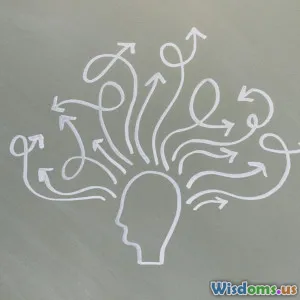
The Science Behind Dreaming
9 min read Explore the fascinating science behind dreaming and what happens in our brains during sleep. (0 Reviews)
The Science Behind Dreaming: Unlocking the Mysteries of the Sleeping Brain
From time immemorial, dreams have enthralled people—fluttering shadows of an unseen world where reality blurs and imagination runs wild. But beyond folklore and symbolism lies a scientific question that has mesmerized neuroscientists for decades: What exactly happens in the brain when we dream? In this article, we'll delve deeply into the brain science behind dreaming, reveal the processes that forge our nocturnal narratives, explore the functions dreams may serve, and shed light on current groundbreaking research.
Understanding Dreams: More Than Just Nighttime Stories
At first glance, dreams seem like a random jumble of images, emotions, and scenarios. Yet, modern science shows dreams result from intricate brain activity involving memory, emotion, and sensory processing.
What Are Dreams?
Dreams are sequences of images, thoughts, emotions, and sensations that usually occur involuntarily during certain stages of sleep, primarily during Rapid Eye Movement (REM) sleep. Although some dreams also occur in non-REM phases, REM dreams tend to be more vivid and narrative-like.
Historical Perspective
Early thinkers like Sigmund Freud interpreted dreams as hidden messages from the unconscious mind—a way to decode repressed desires. While Freud's psychoanalysis influenced dream research, contemporary brain science pursues objectively measurable data, bridging psychology with neuroscience.
The Neurology of Dreaming: Brain Areas in Action
Dreaming involves a complex interplay between various brain regions and neurochemical changes. Key players include:
The Activation-Synthesis Hypothesis
Proposed by Hobson and McCarley (1977), this hypothesis suggests dreams emerge as the brain attempts to synthesize random neural activity from the brainstem during REM sleep. The forebrain crafts this electrical noise into a story-like experience, explaining why dreams often seem bizarre or illogical.
Limbic System and Emotion
Research indicates heightened activity within the limbic regions, particularly the amygdala, during dreaming. This aligns with the emotionally intense nature of dreams, explaining why they often evoke fear, pleasure, or anxiety. For example, nightmare sufferers show exaggerated amygdala activation, hinting at a link between emotional processing and dream vividness.
Prefrontal Cortex Suppression
The prefrontal cortex governs logic, planning, and self-control but is notably less active during REM sleep. This reduced activity helps account for the strange, illogical stories our brain concocts overnight—and why we're often less critical or skeptical about dream content while experiencing it.
Visual Cortex Activation
Unlike waking, when the eyes drive visual input, during REM sleep, the visual cortex activates without external stimuli. This partly explains the rich, colorful imagery of many dreams. Studies using functional MRI have identified this focal activation in dreaming subjects.
The Purpose of Dreaming: Why Do We Dream?
Despite advances, the definitive purpose of dreaming remains elusive, but several prevailing theories offer insight:
Memory Consolidation
Multiple studies show that REM sleep and associated dreaming contribute to consolidating memories, especially emotionally charged and procedural memories. For example, research by Walker et al. (2002) indicates that REM sleep improves skills like playing an instrument or solving puzzles.
Emotional Regulation
Dreaming may serve a critical role in emotional homeostasis. By replaying emotionally significant events in a low-stakes setting, the brain may help individuals process trauma, anxiety, or stress. Supporting this, people deprived of REM sleep show impaired emotional resilience.
Problem-Solving and Creativity
Some theories suggest dreams provide a sandbox for novel connections between ideas, sparking creativity and problem-solving. Historical figures like Nikola Tesla and Edgar Allan Poe have credited their dreams for breakthrough insights.
Threat Simulation Theory
Proposed by Antti Revonsuo, this hypothesis argues that dreams simulate threatening scenarios to prepare the brain for real-life dangers, enhancing survival through mental rehearsal.
Modern Dream Research: Techniques and Discoveries
Polysomnography and Sleep Studies
These studies combine EEG, eye movement tracking, and muscle tone measurements to understand sleep stages and correlate brainwaves with dream reports. For example, researchers awaken sleepers during various phases to capture immediate dream recollection, providing insight into dream content related to brain state.
Neuroimaging
Functional MRI (fMRI) and PET scans allow visualization of brain activity during REM sleep, revealing which areas light up during dreaming. Advanced machine learning has even enabled researchers to decode some visual dream content based on brain scans, an impressive frontier in translating the dreamer’s subjective experience.
Lucid Dreaming Science
Lucid dreaming—being aware within a dream and sometimes controlling it—opens unique investigative avenues. Studies have shown that lucid dreamers can intentionally move their eyes in predetermined ways during REM sleep to communicate with researchers, allowing real-time interaction and confirmation of dream awareness.
Impact of External Stimuli
Recent experiments explore how auditory or tactile stimuli can influence dreams. For instance, playing relaxing sounds or positive words might improve dream quality and help conditions like PTSD or chronic nightmares.
Real-World Implications and Takeaways
Understanding dreaming is more than academic; it has profound implications:
- Mental Health: Insights into dreams help treat PTSD, anxiety, and depression through therapies like Imagery Rehearsal Therapy (IRT), which alters nightmare patterns.
- Sleep Hygiene: Recognizing the role of REM and dream sleep highlights why consistent, quality sleep is crucial for emotional well-being.
- Cognitive Enhancement: Unlocking the mechanisms of how dreams aid memory and creativity can inform educational and therapeutic approaches.
Conclusion: The Endless Frontier of Dream Science
Dreaming remains one of neuroscience’s most tantalizing puzzles—a nightly theater of the brain’s inner workings. As technology advances, we edge closer to unraveling how our minds weave these vivid experiences. The science behind dreaming not only fascinates but also guides us to appreciate the essential role sleep plays in our health, creativity, and humanity itself. Perhaps, the next time you awaken from a dream, you’ll glimpse the extraordinary neural dance behind those mysterious nighttime stories.
References:
- Hobson, J.A., McCarley, R.W. (1977). The brain as a dream state generator: An activation-synthesis hypothesis of the dream process. American Journal of Psychiatry.
- Walker, M.P., et al. (2002). Sleep-dependent motor memory consolidation. Science.
- Revonsuo, A. (2000). The reinterpretation of dreams: An evolutionary hypothesis of the function of dreaming. Behavioral and Brain Sciences.
- Voss, U., et al. (2009). Lucid dreaming: A state of consciousness with features of both waking and non-lucid dreaming. Sleep.
Explore the wonders of the sleeping brain – your dreams are more than fantasy; they're windows into a sophisticated neurobiological symphony.
Rate the Post
User Reviews
Popular Posts





















